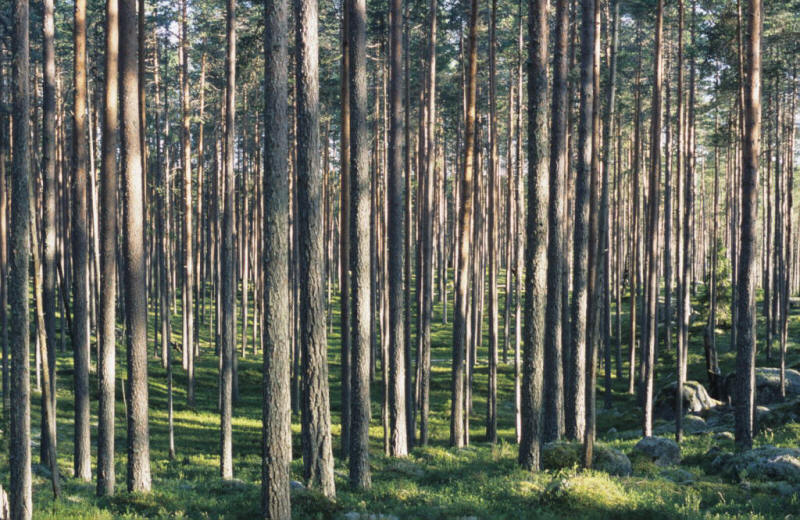|
ENTS,
As I promised in an another thread, I try to describe shortly the
boreal forest (or taiga) found in Finland.
The southwestern tip of Finland is in the hemiboreal zone, which
is a transitional zone between temperate and boreal, and the
northern limits of conifers are in north Finland. So, about the
whole north-south variation of the taiga occurs inside of Finland.
Of the forest area, permafrost is underneath only in a narrow zone
between forest and tundra. In Canada this zone is much wider; I
think that is due to more continental climate: colder winters and
thinner snow cover.
Tree flora in Finland is quite poor. The main tree species are
Pinus sylvestris and Picea abies. They are also the only tree-size
conifers in forests. Open grown Juniperus communis can be a tree up
to 17 metres in southwestern Finland, but in forest it is always a
shrub. I think your American varieties are much lower? Of the
hardwoods, Betula pendula, B.pubescens (they resemble your
B.populifolia and B.papyrifera) and Populus tremula (a close
relative of your P.tremuloides) are most common.
In southern Finland, Picea abies forest is quite productive: even
1000 m3/ha has been measured. The tallest measured Picea abies in
Finland is 44.5 metres (146 ft) tall (in southern Europe it can be
much larger).
On mesic soils the climax vegetation is Picea abies forest.
However, before the influence of man, the forest fire interval has
been so short that fire dependent and shade-intolerant Pinus
sylvestris has been and is still the most common tree species. Picea
cannot penetrate onto dry soils and there Pinus forms pure stands.
In the understorey some of the most common are (from dry poor to
mesic rich soils) lichens, Calluna vulgaris, Vaccinium vitis-idaea,
V.myrtillus, mosses and Oxalis acetosella.
Bogs were very common in Finland, originally about 30% of land
area, but two third of the area has been drained. Forestry has been
very important for the finnish economy and there is not much of
old-growth forest left. Nevertheless forests have retained some of
original character; for example, almost exclusively native tree
species (Pinus, Picea, Betula pendula) are planted after clearcuts,
and clearcut areas are much smaller than in Canada.
In Finland to the north of the northern limits of conifers there
are low woodlands of Betula pubescens subsp. czerepanovii.
The number of conifer species increases from Finland to the east:
first is Larix sibirica (which intergrades to L.gmelinii east of
Ural Mountains), not much east from the Finnish border; next is
Abies sibirica and then Pinus sibirica (a close five-needled
relative of P.albicaulis of western North America). Near the Pacific
Coast in Russian Far East the taiga reaches its maximal diversity.
I attached some photos:

VirginMesicForest
=================
Typical old growth forest on mesic soil in central Finland at an
altitude of 170 metres (560 ft). Trees are Pinus sylvestris and
Picea abies. The existence of Pinus can be explained only by an
forest fire, maybe about 150 years ago. Understorey includes
Vaccinium myrtillus and mosses. Pyhä-Häkki National Park.

VirginDryForest
===============
This stand has initiated by a big forest fire in 1850s. The soil is
too dry for Picea and Pinus is the only tree species. Vaccinium
vitis-idaea dominates the understorey. Pyhä-Häkki National Park.

Helvetinjarvi
=============
Quite old but not virgin forest in central Finland. All the three
most common tree species of Finland can be seen: Pinus sylvestris
(yellow-brown trunk on the left), Picea abies and Betula pendula. At
the lower edge Juniperus communis. At the right-low corner a small
Sorbus aucuparia. Helvetinjärvi (=lake of the hell) National Park.

Harz
====
Also in Europe taiga-like communities can be found on mountains of
central and southern Europe. In this photo old growth Picea abies
forest at the altitude of 950 metres (3100 ft) in central Germany.
(The tree limit is at 1120 metres=3670 ft.) Precipitation is very
high. Soil is rich; this can be seen from the abundance of grasses.
Vaccinium myrtillus and Oxalis acetosella occur, as well. Harz
National Park.
Kouta
Continued at:
http://groups.google.com/group/entstrees/browse_thread/thread/5b7bee6f00490aca?hl=en
|